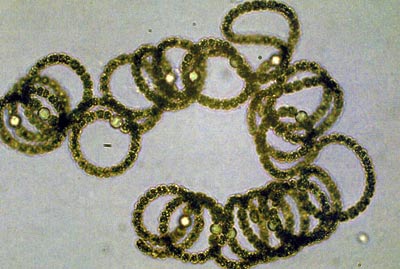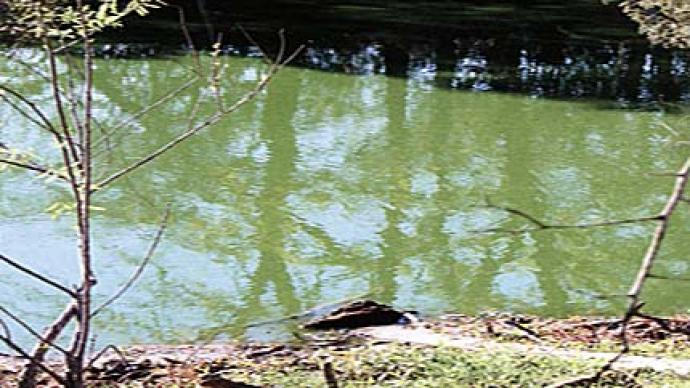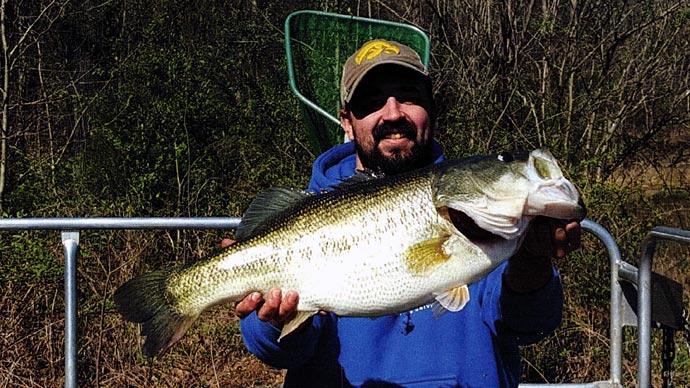
Fertilizing lakes and ponds to produce plankton blooms has been widely adopted over the past 50 years, and is considered one of the most important management strategies when trying to grow trophy Largemouth bass. It is a skill that is best learned firsthand through experience and repetition, and takes time to master. As result, there is a gap in knowledge between professionals with a great deal of experience and those who have limited experience.
When biologists refer to the productivity of a plankton bloom, they are referring to the bloom's ability to fuel the food chain. Insufficient productivity will limit Largemouth bass growth by reducing the number of forage fish the waterbody can support.
Alternatively, excessive productivity will result in compromised water quality and stressing fish, which adversely impacts fish growth and survival. The ideal amount of productivity can be difficult to achieve and maintain, but will have a synergistic effect on bass growth if accomplished.
Properly fertilizing lakes and ponds requires a balanced approach tailored to the specific waterbody. Before initiating a fertilization program, it is important to first determine if a fertilizing program is the right fit. In some cases, the work required to establish a sustainable plankton bloom is cost prohibitive. This can be due to high flow rates or simply the size of the waterbody, which may require large, recurring applications of lime or fertilizer to maintain a bloom. In other cases, the cost of herbicides or algaecides required to keep undesired growth under control can make fertilizing too expensive. For those with hypereutrophic waterbodies, the cost of reducing phosphorus levels using aeration or nutrient mitigation products may also be too costly.
To determine if fertilizing is a feasible approach, it is important to have a grasp on baseline data such as free and total in-water phosphorus levels, alkalinity, pH, historical as well as current knowledge of aquatic vegetation and algae growth, water flow rates throughout the year, and watershed management practices. Using this information, you can project what it will cost to sustain an appropriate bloom, as well as gain an understanding of how much labor will be required.
If fertilizing is deemed an appropriate management strategy based on goals and budget, it is critical that you establish a plankton monitoring program so that you know when and how much fertilizer to add. Before we outline an example of an effective monitoring program, it's important to further examine the goals we hope to achieve.
When managing productive waterbodies, the term plankton is typically used to describe a culmination of phytoplankton (green algae), blue-green algae (cyanobacteria), and zooplankton.
Phytoplankton and zooplankton are desirable and contribute to the biomass of fish that a waterbody can support. Blue-green algae are undesirable for several reasons. They are not readily consumed by zooplankton. As a result, they lock up and prevent nutrients from being passed up the food chain. They are also capable of producing toxins that threaten the health of nearly all wildlife, as well as dogs, fish, cattle, and humans. Unfortunately, blue-green algae are visually similar in green color and appearance to beneficial plankton species, often causing them to be incorrectly interpreted as productive.
A fundamental skill required to properly fertilize lakes and ponds is the ability to identify the quality of the current bloom. One step in this process is to characterize the water's color, as the color will vary depending on the plankton species present. When doing this, it is best to use a series of descriptive words to classify its color: bright green, green, olive green, olive brown, brown, and clear. Tracking the color over time is one of the primary data points utilized when determining if additional fertilizer is required. Think of it as plants are green (phytoplankton) and animals are brown (zooplankton). The fertilizer applied to the water feeds the phytoplankton, who are then consumed by the zooplankton, which are then consumed by small fish and invertebrates. This continual shifting in phytoplankton and zooplankton populations is why the color of lakes and ponds have the tendency to change throughout the growing season. The one drawback with this process of using color to interpret a bloom is that many who fertilize struggle to accurately identify when blue-green algae are present. With proper training, visual observations can help verify the presence of blue-green algae, but for many it is best to send a water sample to a professional to help verify if they are present, as well as quantify if their biomass is a concern.
In addition to color, bloom density is an important variable to monitor. This is done using a Secchi disk to determine how far you can see into the water. An ideal Secchi disk reading will vary throughout the year depending on variables that tie back to water quality, such as water temperature, season, upstream watershed practices (such as fertilizing), weather patterns (such as drought), and the presence of surface aeration. Depending on the current level of risk, most managers target a Secchi reading between 16 and 30 inches.
When waterbodies have a dense plankton bloom, there is an inherent risk of water quality deteriorating. Blooms that are too dense are referred as over-productive (i.e. the bloom is running the risk of requiring more dissolved oxygen than is available). As a result, blooms that are too dense can put stress on fish by depleting oxygen, or even cause a fish kill. As a generalization, dense blooms that are green—especially bright green—are at a higher risk of depleting the oxygen when compared to other bloom colors. That said, oxygen crashes can occur at any stage of a plankton blooms cycle, which is why fertilized waterbodies should be closely monitored on a routine schedule.
A typical plankton monitoring program gathers routine in-field data to properly track the bloom's cyclical pattern, allowing managers to intervene and manipulate the bloom as needed to keep it properly balanced. All fertilization programs should track the following data on a routine basis throughout the growing season: bloom color, Secchi reading (visibility), water temperature, dissolved oxygen, pH, time of day the data was collected, and current weather patterns/trends. More advanced fertilization programs designed to maximize bass growth while minimizing the presence of toxin producing blue-green algae species will require monitoring additional parameters such as nitrogen, phosphorus, and chlorophyll-A, as well as identify what algae species are present. Taking the more advanced fertilization approach is noticeably more expensive, but depending on the goals and water uses, it can be money well spent, as it helps ensure the waterbody's bloom is as productive as possible while also helping to ensure it is a safe bloom that is not producing toxins.
An example of how a bloom could develop and transition over time on a fertilizing program looks as follows: In the spring, following an initial fertilizing application, the water shifts from clear with a 38-inch Secchi reading to bright green with a 20-inch visibility over the course of two weeks following the initial fertilizer application. Over the following three weeks, the water color then transitions to green, and then olive green before moving to an olive brown color that has a 26-inch visibility. Over the course of this transition, the phytoplankton (green algae) population utilized the available nutrients to build their population, which gave the water the bright green and green color. Then, with an abundant amount of available food, the zooplankton population began to increase, shifting the color to an olive green, and then eventually an olive brown color as the populations continued to shift from phytoplankton to zooplankton. Olive brown is a nice productive color for a bloom, as it indicates the zooplankton population is doing well, while there is still the presence of phytoplankton to support the desirable zooplankton.
In this example, the bloom peaked with a 20-inch Secchi reading before it receded back to 26 inches. This is a critical observation, as it indicates the bloom is receding, and that additional fertilizer can be applied to increase the density if desired. A good fertilization program will continually make these observations. Teaming this data with all of the other variables that influence the blooms strength, biologists and managers are able to make an educated decision about whether to apply more fertilizer, as well as how much.
Some ponds maintain a nice olive green or olive brown color for months at a time, while others cycle back and forth between green and brown throughout the entire growing season. Much of a waterbody's rhythm has to do with the ability of the plankton populations to establish a dominant presence, as well as whether or not the appropriate amounts of nitrogen and phosphorus are available for the green algae to thrive.
If it is the first time a waterbody is being put on a fertilization program, it is best to ease into the process until you learn how the bloom will respond. After maintaining a program for a while, the bloom will oftentimes settle into a rhythm and it will become easier to predict how it may respond to fertilizer applications. This is especially true after a fertilization program has been implemented for several years.
Ultimately, it's important to keep in mind that fertilizing is a skill best learned first-hand through experience and repetition, and that a wide variety of variables will influence the decisions made throughout the process. The strength of a fertilizing program, as well as your likelihood to succeed, is greatly influenced by the quality and consistency of a monitoring program. Understand that blue-green algae are a significant issue that compromises the quality, health, and safety of the waterbody, and is typically overlooked as a non-issue. When budgets allow, hire an experienced biologist to oversee your fertilizing program; a professional expertise will help ensure that your fishery progresses and that you reach your goals.



